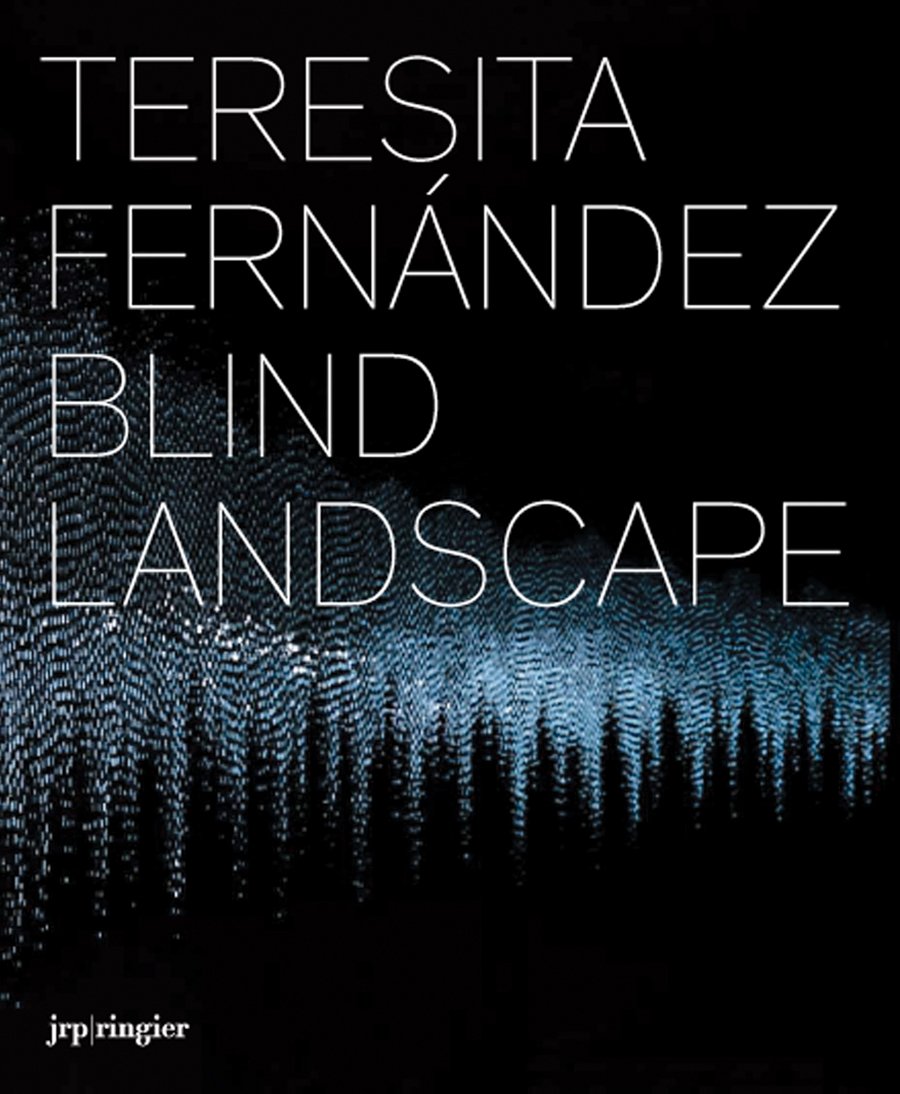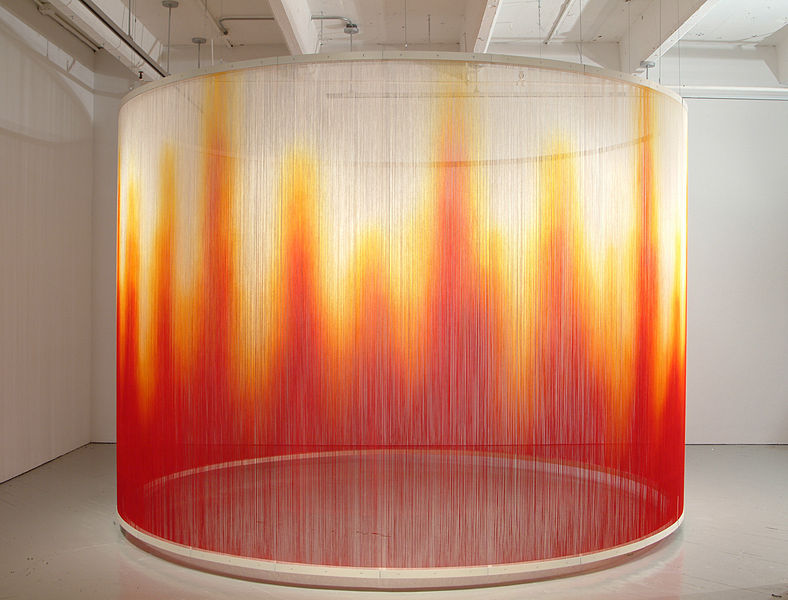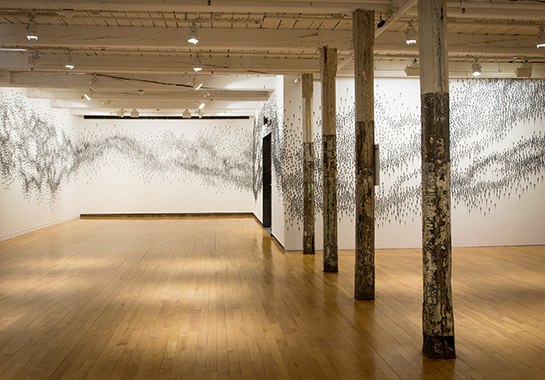
What It Really Takes to Be an Artist: MacArthur Genius Teresita Fernández’s Magnificent Commencement Address
by Maria Popova
“Being an artist is not just about what happens when you are in the studio. The way you live, the people you choose to love and the way you love them, the way you vote, the words that come out of your mouth… will also become the raw material for the art you make.”
 In 2005, artist Teresita Fernández — one of the most original and visionary sculptors of our time, whose work appears in the bewitching monograph Blind Landscape(public library) — received one of those legendary phone calls from the MacArthur Foundation. The mysterious caller informed her that the foundation’s secret committee had awarded the coveted MacArthur Fellowship — a generous $500,000 grant, with no strings attached, given solely so that the recipient can continue pursuing her or his creative work.
In 2005, artist Teresita Fernández — one of the most original and visionary sculptors of our time, whose work appears in the bewitching monograph Blind Landscape(public library) — received one of those legendary phone calls from the MacArthur Foundation. The mysterious caller informed her that the foundation’s secret committee had awarded the coveted MacArthur Fellowship — a generous $500,000 grant, with no strings attached, given solely so that the recipient can continue pursuing her or his creative work.
In May of 2013, two years after her appointment to President Barack Obama’s Commission of Fine Arts, Fernández delivered a spectacular keynote address to the graduating class at her alma mater, Virginia Commonwealth University’s School of the Arts. Titled “On Amnesia, Broken Pottery, and the Inside of a Form,” the speech is a fine addition to the greatest commencement addresses of all time and a masterwork of the “connected irrelevance” that characterizes MacArthur “geniuses.” It is also an invaluable trove of hard-earned wisdom on the creative life, with great resonance for all stages of life. Annotated highlights below.
On the usefulness of “useless” knowledge, how we really learn about life, and the true seed of creative work:
For some inexplicable reason, we seem to believe most strongly not in the actual formal lessons, but rather in those details that get into our heads without our knowing exactly how they got there. Those pivotal lessons in our lives continue to work on us in subtle, subterranean ways.This kind of amnesia is life’s built-in way of making sure you filter out what’s not very important. You graduate today after years of hard work, immersive years of learning, absorbing, processing, accumulating, cramming, finishing, focusing. There are no more reasons, really, to even make art unless you really truly want to. Of all you learned you probably don’t need to remember most of the technical or theoretical information, as that’s all easily accessible with a quick search. And what you will remember will have less to do with the past and more to do with how it triggers reactions for you in the present. Oddly enough, what we involuntarily do retain is meant to help us move forward. This forthcoming amnesia that awaits you is just another kind of graduation, another step in a lifetime of many graduations.You are about to enter the much more difficult phase of unlearning everything you have learned in college, of questioning it, redefining it, challenging it, and reinventing it to call it your own. More than in any other vocation, being an artist means always starting from nothing. Our work as artists is courageous and scary. There is no brief that comes along with it, no problem solving that’s given as a task… An artist’s work is almost entirely inquiry based and self-regulated. It is a fragile process of teaching oneself to work alone, and focusing on how to hone your quirky creative obsessions so that they eventually become so oddly specific that they can only be your own.

Teresita Fernández: 'Fire,' 2005
She recounts being fascinated by an ancient Greek ostracon at the Metropolitan Museum of Art — a piece of broken pottery or stone, engraved with a message, often used as a voting ballot — and how it reveals the fragmentary nature of creativity:
I was enamored with the idea of how what seemed broken, discarded, useless was transformed into a meaningful gesture… We are conditioned to think that what is broken is lost, or useless or a setback, and so when we set out with big ambitions we don’t necessarily recognize what the next graduation is supposed to look like. Unlearning everything you learned in college is just an exercise in learning to recognize how the fragments and small bits lead to something that is much more than the sum of its parts.
Echoing Nietzsche’s magnificent case for the value of difficulty, Fernández offers a wonderfully fresh perspective on failure amid a culture mired in “fail forward” clichés:
In Japan there is a kind of reverence for the art of mending. In the context of the tea ceremony there is no such thing as failure or success in the way we are accustomed to using those words. A broken bowl would be valued precisely because of the exquisite nature of how it was repaired, a distinctly Japanese tradition of kintsugi, meaning to “to patch with gold”. Often, we try to repair broken things in such a way as to conceal the repair and make it “good as new.” But the tea masters understood that by repairing the broken bowl with the distinct beauty of radiant gold, they could create an alternative to “good as new” and instead employ a “better than new” aesthetic. They understood that a conspicuous, artful repair actually adds value. Because after mending, the bowl’s unique fault lines were transformed into little rivers of gold that post repair were even more special because the bowl could then resemble nothing but itself. Here lies that radical physical transformation from useless to priceless, from failure to success. All of the fumbling and awkward moments you will go through, all of the failed attempts, all of the near misses, all of the spontaneous curiosity will eventually start to steer you in exactly the right direction.
Fernández extends gentle assurance that art, like science, is driven by “thoroughly conscious ignorance”:
In those moments when you feel discouraged or lost in the studio, or when you experience rejection, rest completely assured that what you don’t know about something is also a form of knowledge, though much harder to understand. In many ways, making art is like blindly trying to see the shape of what you don’t yet know. Whenever you catch a little a glimpse of that blind spot, of your ignorance, of your vulnerability, of that unknown, don’t be afraid or embarrassed to stare at it. Instead, try to relish in its profound mystery. Art is about taking the risk of engaging in something somewhat ridiculous and irrational simply because you need to get a closer look at it, you simply need to break it open to see what’s inside.
With a bow to Georgia O’Keeffe’s undying wisdom on what it really means to be an artist — “Whether you succeed or not is irrelevant—there is no such thing. Making your unknown known is the important thing.” — Fernández echoes Thoreau and exhorts us to break the tyranny of external definitions of success:
We live in a meritocratic society, where accomplishments are constantly being measured externally, where forms are always read from the outside, where comfort and lifestyle are often mistaken for success, or even happiness. Don’t be fooled. Our ideas regarding success should be our own, and I urge you to pursue it simultaneously from both the inside and the outside… As artists, it will be especially difficult to measure these ideas of what success may be because you have chosen a practice that is entirely dependent on being willing to possibly fail, over and over again regardless of any successes that do come your way.
In a sentiment that calls to mind John Steinbeck’s unforgettable moment of choosing creative integrity over outward success — “I beat poverty for a good many years and I’ll be damned if I’ll go down at the first little whiff of success.” — Fernández adds:
Success is just another form, with both an inside and outside.For the most part people are aware of what the outside of success looks like… Outside success always seems to look terribly glamorous, and every once in a while it can be. But it still never means all that much, and it still never makes the work of the work any easier — if anything, it makes it a little harder because the stakes get higher; the possible humble failures become less private and more visible and more cruelly judged.
With assuring vulnerability, she reflects on her own experience of befriending that frightening moment after the completion of a major project, which she likens to a kind of creative hangover:
A kind of panic sets in the very next day, an urge to get into the studio because you know you have to start all over again, building something from nothing, seeking the company of those trusted beneficial failures, waiting for those absurd internal dialogues with your own gang of voices. It’s not a very glamorous scenario. But this is precisely what internal success looks like. It is visible only to yourself and while you can trick the rest of the world into thinking you are a good artist, you can never really convince yourself, which is why you keep trying. If you’re lucky and motivated enough to keep making art, life is quiet, you get to work at what you love doing, happily chipping away at something, constructing something, adjusting to a cycle of highs and lows and in betweens, and it doesn’t matter if you’ve been doing it for two years or 50 years, the patterns remain exactly the same. The anxiety continues to set in, the doubts creep in, the baby steps towards mending fragments starts all over again, the cautious urge to peek between the cracks is there. When you find yourself in that place, that’s when you’ll know that the inside is driving the outside.[…]That hunger, that desire for success is nothing more than a fear of failure… And the odd thing is that when you are actually succeeding, it tends to be quiet and comes always quite unannounced and without a lot of fanfare. You will, in fact, be the only person who ever really grasps or recognizes the internal successes. The work of the work is visible only to yourself.

Work from Teresita Fernández's 2014 MASS MoCA solo show, 'As Above So Below'
At the end, Fernández offers graduates ten practical tips on being an artist that have been helpful on her own creative journey — but they double as an ennobling moral compass for being a decent human being in any walk of life:
- Art requires time — there’s a reason it’s called a studiopractice. Contrary to popular belief, moving to Bushwick, Brooklyn, this summer does not make you an artist. If in order to do this you have to share a space with five roommates and wait on tables, you will probably not make much art. What worked for me was spending five years building a body of work in a city where it was cheapest for me to live, and that allowed me the precious time and space I needed after grad school.
- Learn to write well and get into the habit of systematically applying for every grant you can find. If you don’t get it, keep applying. I lived from grant money for four years when I first graduated.
- Nobody reads artist’s statements. Learn to tell an interesting story about your work that people can relate to on a personal level.
- Not every project will survive. Purge regularly, destroying is intimately connected to creating. This will save you time.
- Edit privately. As much as I believe in stumbling, I also think nobody else needs to watch you do it.
- When people say your work is good do two things. First, don’t believe them. Second, ask them, “Why”? If they can convince you of why they think your work is good, accept the compliment. If they can’t convince you (and most people can’t) dismiss it as superficial and recognize that most bad consensus is made by people simply repeating that they “like” something.
- Don’t ever feel like you have to give anything up in order to be an artist. I had babies and made art and traveled and still have a million things I’d like to do.
- You don’t need a lot of friends or curators or patrons or a huge following, just a few that really believe in you.
- Remind yourself to be gracious to everyone, whether they can help you or not. It will draw people to you over and over again and help build trust in professional relationships.
- And lastly, when other things in life get tough, when you’re going through family troubles, when you’re heartbroken, when you’re frustrated with money problems, focus on your work. It has saved me through every single difficult thing I have ever had to do, like a scaffolding that goes far beyond any traditional notions of a career.
Indeed, Fernández’s parting point is also her most poignant — a reminder that being human is the wider circle within which being an artist resides, and that our art is always the combinatorial product of the fragments of who we are, of our combinatorial character:
Being an artist is not just about what happens when you are in the studio. The way you live, the people you choose to love and the way you love them, the way you vote, the words that come out of your mouth, the size of the world you make for yourselves, your ability to influence the things you believe in, your obsessions, your failures — all of these components will also become the raw material for the art you make.
Complement with Debbie Millman’s fantastic commencement address on courage and the creative life and Jeanette Winterson on how art creates a sanctified space for the human spirit.
No comments:
Post a Comment